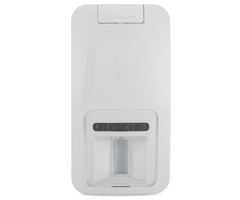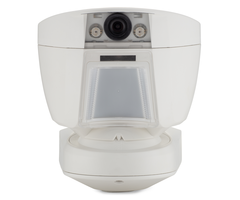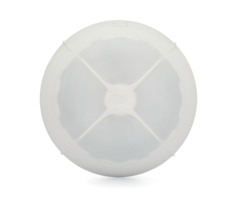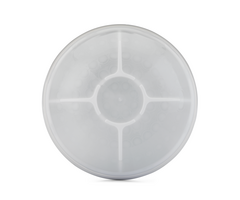Advantages of Using a PowerG Motion Sensor
Related Products







Description
https://www.alarmgrid.com/faq/should-i-get-a-powerg-motion http://alrm.gd/get-monitored.
Transcript
Hey, DIYers. Jarrett here from Alarm Grid. Today we're going to be discussing whether you should use PowerG motion sensors. The answer is yes. You do want to go ahead and use those PowerG motion sensors, as long as you have a system that can support PowerG. Now, there are certain systems that can support PowerG devices, as those are specifically made devices for certain systems. So for instance, if you have the Qolsys IQ Panel 2 Plus version that does have the PowerG set up in it, then you can go ahead and use those. There are three different versions of the Qolsys IQ Panel 2 plus. There is the Honeywell 345 megahertz version. There is the DSC 433 megahertz version. And then there's the Qolsys and Interlogix 319.5 megahertz version. We'll be covering those different versions a little bit later, and other different type of motion sensors you can use with those. But if you have one of them, those do support PowerG, as the PowerG data card is built into it. Now, the other system you could use would be a DSC PowerSeries Neo system. That can support PowerG sensors, as long as you have a PowerG compatible keypad. There's a specific keypad that is made for those that would allow that system to use PowerG sensors. If you don't have it, there's no way you can use those, unfortunately. And then the last system would be the DSC iotega system. This is one of DSC's newest wireless systems they have come out with, and that does have the PowerG compatibility right out of the box. Now, the reason why you want to go ahead and use PowerG sensors or motion sensors is because they are-- they're very good to use. They have encryption-- 128-bit encryption technology, which is military grade. They are meant to go very long distances as-- basically, they're built to be put in areas where you're going to be stretching that communication range between the system and the sensor. So essentially, if you want a sensor that would have both encryption and long-range technology, then the PowerG sensors would be the way to go. Now, what I mean by the long-range technology here is like PowerG sensors, they're rated to go about 2,000 feet. Between the system and the sensor, you have about 2,000 feet you can go. Now, that is if you have it an open-air situation where there's nothing in between the sensor and that panel. But either way, these are meant to go very long distances. Even if you put these in a building, they still go very far. So very good to use, very convenient to use and everything, and they just work very well. So one other thing I do want to add about the encryption is it's not just 128-bit encryption, it's 128 AES encryption, which is still-- I mean, it's military grade encryption, but still does the job very well. Just wanted to correct that part a little bit. Now, there are different type of PowerG motion sensors and everything you can use. There's a couple of different ones you could choose from. However, the one that is mainly used is the PowerG PG9-- or the DSC PG9914. This one is actually-- this is included normally in a lot of the kits that we have available for the Qolsys IQ Panel 2 Plus. You have this motion detector that's included. And it's a very good motion detector. It's very, very nice to use inside of a home setting or even a business setting. They have about a 39-foot range, detection range. And then if you have any pets or anything in the location, it does have pet immunity for up to about 85 pounds for that animal. So very nice sensor to use. And again, it does come with a majority of our kits that we have available. Now, as I said, there are other different types of PowerG motion detectors available. That includes the PG9947P. This has mirror optics built into it. It is a really good motion detector as well, but you would need to purchase that separately. Then you have the dual tech DSC PG9984P, and then the PG9962. And the PG9962 is actually a ceiling mount sensor. So you basically just pop it up on the ceiling, and it has a very good detection range there as well. Those are some of the other ones you can use. Now, if you do want to go ahead and use those, again, they will need to be purchased separately. They don't come with any of the kits. Unfortunately, you can't just throw those in the kits, either. So they are all available on our website. But if you do want to go ahead and use those, or if you have any questions on those, just let us know. So now I want to move over to the Qolsys IQ Panel 2 Plus systems. As I said, there's three different versions available. There's the Honeywell 1, DSC 1, and then you have the Qolsys and Interlogix version. Now, these do support PowerG, but they also support different type of motion sensors as well. You can use those if you want to, but if you want that encryption and the long range, it's best if you use the PowerG motion sensor, because those come with it built in. The other motion sensors that are compatible, unfortunately, it's not really going to be any that have that long range. And the only one that does have the encryption would be if you're using the 319.5 megahertz version of the Qolsys, and you use the Qolsys motion IQ-S. So the Qolsys IQ Motion-S, it is a good motion sensor as well. It does have S-line encryption, though. That is Qolsys's version of encrypted technology, and it's using rolling code encryption. Now, it is very good to use, does work very well, but it's not going to be as secure as the PowerG 128-bit AES encryption. So if you want something that's going to have a little more punch, a little bit more of a secure connection between the panel and that sensor, then you want to go with that PowerG motion sensor, which the one that we do recommend overall is the PG9914. You can use the other ones if you want to, depending on the area and situation that you're working with. Now, the other two versions of this would be the Honeywell 345 megahertz version. Now, this isn't just a Honeywell. So that version of the Qolsys can support Honeywell and 2GIG sensors, actually. Both use the 345 megahertz frequency. Now, if you want to go ahead and use like a different motion sensor other than PowerG, there is the Honeywell 5800PIR-COM. That is also a pretty good motion sensor. It has a detection range of about 60 foot-- 60 feet by 80 feet. And it actually can be programmed in a few different ways. You can set up different loops on that motion detector, where it could even support a temperature sensor, or its temperature sensing. So if you want to have a little bit of different options of stuff with that motion sensor, go ahead and use that. That is compatible with that version of the Qolsys. Again, if you want the long range and the encryption, you want to go with the PowerG version. And then the last version of the Qolsys would be the DSC 433 megahertz version of the Qolsys IQ Panel 2 Plus. Now, that one is only able to support DSC sensors and PowerG sensors. That's not able to support any others. Now, if you did want to use a DSC sensor, then you can use the DSC WS490P. That one is pretty good as well, but it's not going to have that encryption. It's not really going to have the long range either. So you want to keep that in mind when you're setting those up. One last thing, though, that I do want to add about that 5800PIR-COM is that it does have-- you're not going to have that long range-- as much of a long range. They're said to go about 200 feet instead of 2,000 feet like the PowerG. Now, 200 feet being in an open air situation, though-- essentially, nothing in between the system and the sensor. When you put that into a building, you could still get a good pretty good range with it. But it's not going to be as powerful as that PowerG. So the question is, should I use PowerG motion sensors? The answer is definitely going to be yes. They're extremely good sensors to use, and they're very convenient for different situations. If you have any further questions about PowerG motion sensors or alarm systems in general, please reach us at support@alarmgrid.com, or go to our website, alarmgrid.com. If you found this video helpful, please like and subscribe. If you want notifications of future videos, please click the bell icon. This is Jarrett with AlarmGrid. You have a great day.
- Uploaded




